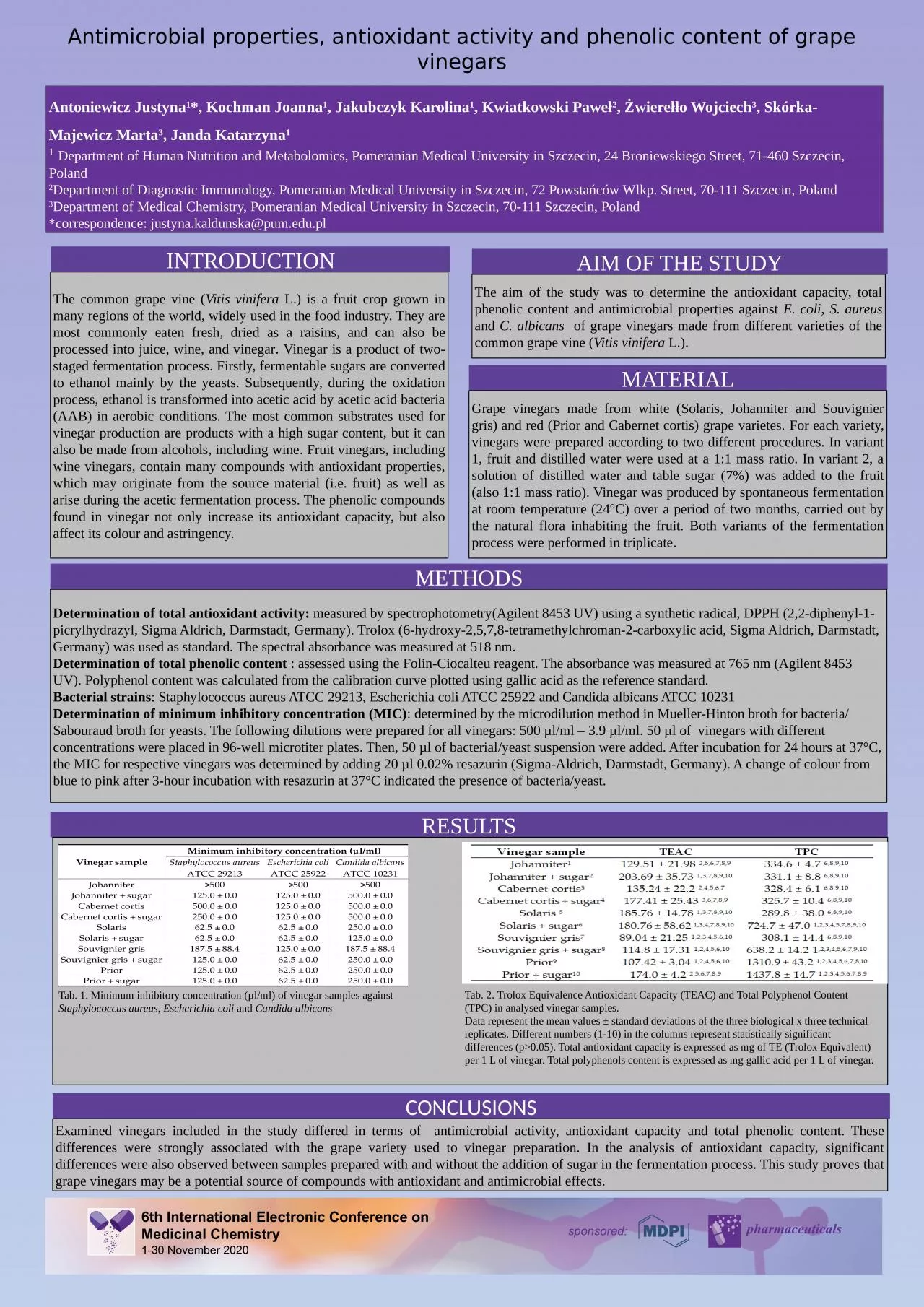

s antioxidant activity and phenolic content of grape vinegars A ntoniewicz Justyna 1 Kochman Joanna 1 Jakubczyk Karolina 1 Kwiatkowski Paweł 2 Żwierełło Wojciech ID: 1012040
Download Presentation The PPT/PDF document "Antimicrobial propertie" is the property of its rightful owner. Permission is granted to download and print the materials on this web site for personal, non-commercial use only, and to display it on your personal computer provided you do not modify the materials and that you retain all copyright notices contained in the materials. By downloading content from our website, you accept the terms of this agreement.
1. Antimicrobial properties, antioxidant activity and phenolic content of grape vinegarsAntoniewicz Justyna1*, Kochman Joanna1, Jakubczyk Karolina1, Kwiatkowski Paweł2, Żwierełło Wojciech3, Skórka- Majewicz Marta3, Janda Katarzyna11 Department of Human Nutrition and Metabolomics, Pomeranian Medical University in Szczecin, 24 Broniewskiego Street, 71-460 Szczecin, Poland2Department of Diagnostic Immunology, Pomeranian Medical University in Szczecin, 72 Powstańców Wlkp. Street, 70-111 Szczecin, Poland3Department of Medical Chemistry, Pomeranian Medical University in Szczecin, 70-111 Szczecin, Poland*correspondence: justyna.kaldunska@pum.edu.plRESULTSTab. 1. Minimum inhibitory concentration (µl/ml) of vinegar samples against Staphylococcus aureus, Escherichia coli and Candida albicansTab. 2. Trolox Equivalence Antioxidant Capacity (TEAC) and Total Polyphenol Content (TPC) in analysed vinegar samples.Data represent the mean values ± standard deviations of the three biological x three technical replicates. Different numbers (1-10) in the columns represent statistically significant differences (p>0.05). Total antioxidant capacity is expressed as mg of TE (Trolox Equivalent) per 1 L of vinegar. Total polyphenols content is expressed as mg gallic acid per 1 L of vinegar.INTRODUCTIONThe common grape vine (Vitis vinifera L.) is a fruit crop grown in many regions of the world, widely used in the food industry. They are most commonly eaten fresh, dried as a raisins, and can also be processed into juice, wine, and vinegar. Vinegar is a product of two-staged fermentation process. Firstly, fermentable sugars are converted to ethanol mainly by the yeasts. Subsequently, during the oxidation process, ethanol is transformed into acetic acid by acetic acid bacteria (AAB) in aerobic conditions. The most common substrates used for vinegar production are products with a high sugar content, but it can also be made from alcohols, including wine. Fruit vinegars, including wine vinegars, contain many compounds with antioxidant properties, which may originate from the source material (i.e. fruit) as well as arise during the acetic fermentation process. The phenolic compounds found in vinegar not only increase its antioxidant capacity, but also affect its colour and astringency. AIM OF THE STUDYThe aim of the study was to determine the antioxidant capacity, total phenolic content and antimicrobial properties against E. coli, S. aureus and C. albicans of grape vinegars made from different varieties of the common grape vine (Vitis vinifera L.).MATERIALGrape vinegars made from white (Solaris, Johanniter and Souvignier gris) and red (Prior and Cabernet cortis) grape varietes. For each variety, vinegars were prepared according to two different procedures. In variant 1, fruit and distilled water were used at a 1:1 mass ratio. In variant 2, a solution of distilled water and table sugar (7%) was added to the fruit (also 1:1 mass ratio). Vinegar was produced by spontaneous fermentation at room temperature (24°C) over a period of two months, carried out by the natural flora inhabiting the fruit. Both variants of the fermentation process were performed in triplicate.METHODSDetermination of total antioxidant activity: measured by spectrophotometry(Agilent 8453 UV) using a synthetic radical, DPPH (2,2-diphenyl-1-picrylhydrazyl, Sigma Aldrich, Darmstadt, Germany). Trolox (6-hydroxy-2,5,7,8-tetramethylchroman-2-carboxylic acid, Sigma Aldrich, Darmstadt, Germany) was used as standard. The spectral absorbance was measured at 518 nm. Determination of total phenolic content : assessed using the Folin-Ciocalteu reagent. The absorbance was measured at 765 nm (Agilent 8453 UV). Polyphenol content was calculated from the calibration curve plotted using gallic acid as the reference standard. Bacterial strains: Staphylococcus aureus ATCC 29213, Escherichia coli ATCC 25922 and Candida albicans ATCC 10231Determination of minimum inhibitory concentration (MIC): determined by the microdilution method in Mueller-Hinton broth for bacteria/ Sabouraud broth for yeasts. The following dilutions were prepared for all vinegars: 500 µl/ml – 3.9 µl/ml. 50 µl of vinegars with different concentrations were placed in 96-well microtiter plates. Then, 50 µl of bacterial/yeast suspension were added. After incubation for 24 hours at 37°C, the MIC for respective vinegars was determined by adding 20 µl 0.02% resazurin (Sigma-Aldrich, Darmstadt, Germany). A change of colour from blue to pink after 3-hour incubation with resazurin at 37°C indicated the presence of bacteria/yeast. CONCLUSIONSExamined vinegars included in the study differed in terms of antimicrobial activity, antioxidant capacity and total phenolic content. These differences were strongly associated with the grape variety used to vinegar preparation. In the analysis of antioxidant capacity, significant differences were also observed between samples prepared with and without the addition of sugar in the fermentation process. This study proves that grape vinegars may be a potential source of compounds with antioxidant and antimicrobial effects.